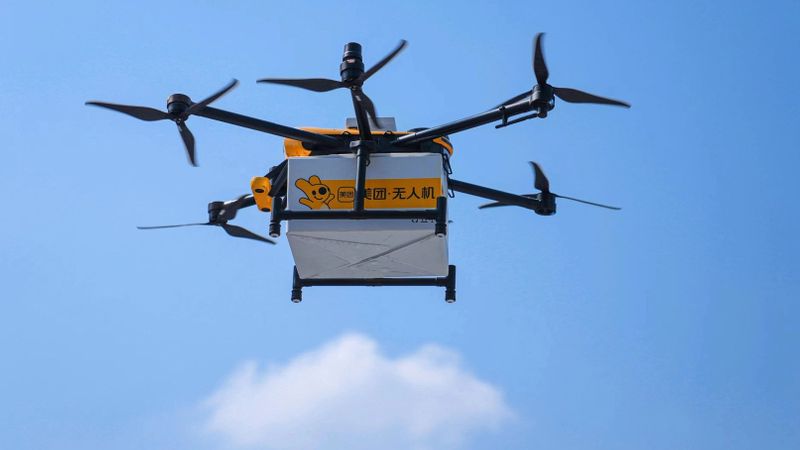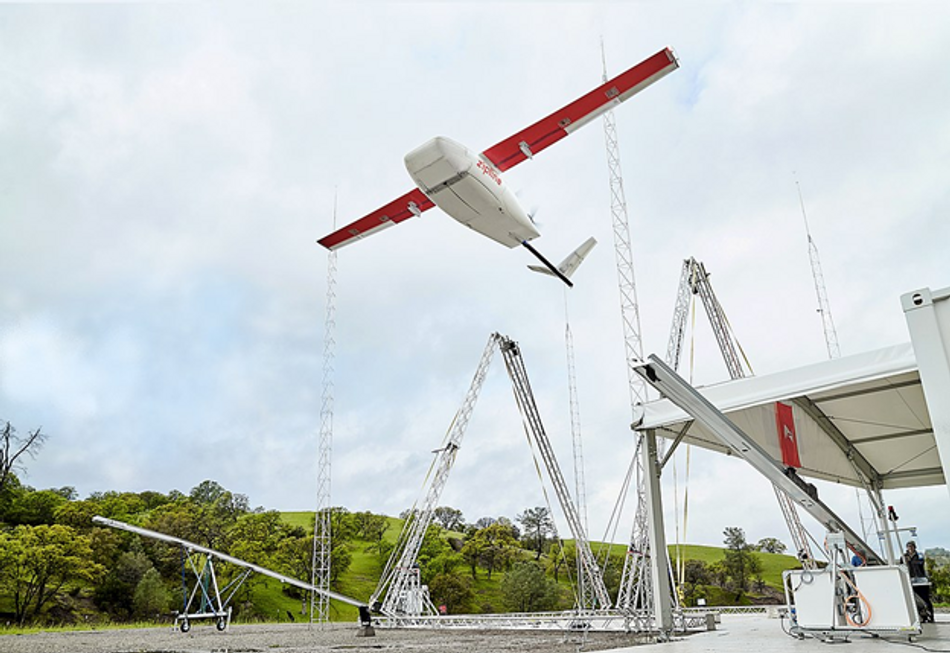Looking Up for Your Packages: The Evolution and Future of Drone Delivery Technology
Drone delivery represents a significant technological advancement in logistics.

Image credit: MEITUAN
Drone delivery represents a groundbreaking shift in logistics, intertwining technology with the everyday need for fast, efficient package delivery. This innovation has spurred anticipation and speculation about its potential to revolutionize the delivery landscape, promising speed and convenience previously unimaginable. Yet, the path to its realization is paved with challenges and triumphs, reflecting a continuous technological evolution and adaptation journey.
Historical Barriers to Drone Delivery
Regulatory Challenges
Aviation laws crafted for manned aircraft did not foresee the rise of unmanned aerial vehicles (UAVs) has resulted in a regulatory landscape ill-prepared for drones' unique demands and operational characteristics. The variations in these regulations across different countries and regions further complicated the picture. In some areas, strict airspace control and stringent UAV regulations severely limited the operational freedom necessary for commercial drone delivery, leading to a slower pace of adoption and innovation.
These regulations often required extensive navigation through bureaucratic channels, delaying pilot programs and full-scale implementations. The struggle to fit the square peg of drone delivery into the round hole of traditional aviation regulations has been a defining aspect of its early development stages.
Technical Limitations
In their nascent stages, drones were plagued by restricted battery life, limiting their range and endurance. Early navigation systems were rudimentary, lacking the sophistication needed for precise, reliable delivery operations. Payload capacity was another critical issue, as initial drones could carry only minimal weight, rendering them impractical for most commercial delivery applications. Control mechanisms were also in their infancy, lacking the advanced features necessary for smooth and autonomous operation in varied environments.
These technical barriers impeded the practical application of drone delivery and posed questions about the reliability and efficiency of such a system in a real-world logistics scenario. Overcoming these hurdles required concerted efforts in research and development, pushing the boundaries of what was technically feasible.
Safety and Privacy Concerns
Safety and privacy concerns were at the forefront of drone delivery during the initial phases. Many people within the public and regulation boards were apprehensive of drones, envisioning only how they could lead to accidents and injuries rather than looking at the benefits. With fears of malfunctioning systems leading to collision damage and privacy concerns around unwarranted surveillance and intrusion, it was clear drones had obstacles to pass before they would be widely adopted.
These concerns were not untrue, as early models definitely lacked the sophisticated safety and privacy protocols that are now in development. This apprehension was critical in shaping public perception and regulatory attitudes toward drone delivery, often resulting in more stringent controls and slower adoption rates.
Economic Viability
Finally, the economic viability of drone delivery technology was a significant barrier to its adoption. The initial investment required for developing and deploying drones, especially given their technical and regulatory limitations, was substantial. Businesses and investors questioned whether its promised efficiency and speed could justify the cost of implementing a drone delivery system.
There were concerns about the return on investment, especially in uncertain regulatory environments and unproven technology. This economic skepticism was a major hurdle for early adopters and innovators in the field, who had to refine the technology and demonstrate its cost-effectiveness in a competitive logistics market.
Technological Advances Overcoming Past Barriers
Advancements in Battery and Energy Efficiency
One of the most significant drone technology strides has been battery and energy efficiency. Recent breakthroughs in battery technology have resulted in dramatic improvements in both the energy density and longevity of drone batteries. The result? Longer flight durations and extended operational ranges. This overcomes one of the primary limitations of early drone models.
The addition of alternative energy sources like solar power and hybrid systems has also opened up new possibilities for extended flight times. With these advancements, drones have become more practical for a wider range of delivery routes, including remote locations and those that require lengthier journeys.
Navigation and Autonomy
The integration of advanced GPS and more sophisticated obstacle detection systems has revolutionized navigation and autonomy for drones. With their state-of-the-art navigation systems, drones are able to precisely and reliably navigate complex and dynamic environments.
The systems have the ability to process vast amounts of data, allowing them to navigate around obstacles and adapt to changing conditions with ease. This results in a more autonomous delivery system that can operate successfully with minimal human interaction, therefore reducing potential human error and increasing efficiency.
Safety Mechanisms
The industry has responded to safety concerns by developing systems with advanced collision avoidance along with redundant design features. Drones have safety sensors and software that allow them to detect and avoid obstacles. They also have fail-safe protocols that kick in during emergencies along with robust structural designs to enhance durability. These improvements have played an important role in mitigating the risks of accidents and malfunctions while bolstering the public and regulatory trust in drone systems.
Scalability Solutions
With drone technology continuing to advance, scalability is becoming increasingly prevalent. Drone delivery is becoming more economically viable thanks to mass production and technological refinement. Advancements in the design and manufacturing of drones have led to cost reductions and improvements in their operational efficiency have increased the drone delivery value proposition. This scalability is an essential component of drones becoming widely adopted and transforming the logistics and package delivery landscape.
Current State of Drone Delivery Technology
Latest Drone Models
The landscape of drone delivery technology is characterized by a diverse range of models, each designed for specific delivery tasks. Compact and lightweight drones are being used for small parcel delivery. You’ll find them in urban areas where their agility and small size allow for efficient navigation through tight spaces.
Meanwhile, large drones are equipped to transport heavier weights over long distances. This showcases the versatility of drone technology in various delivery scenarios. Take, for example, the newest Prime Air drones, which are set to operate in select UK and Italian cities along with three U.S. locations by the end of 2024. The MK30, Prime Air's latest model, has been introduced as a notable addition to their fleet. This model stands out for its unique design and capabilities, positioning it as a frontrunner in package delivery drones.
Infrastructure Integration
The integration of drone delivery into existing logistics networks has marked an enormous leap in technology’s practical application. It takes a multifaceted approach, adapting to the current infrastructure and developing new systems designed specifically for UAV operations.
Logistics companies are experimenting with various models to accommodate drone delivery. This includes drone-friendly warehouses, dedicated air corridors for flights, and specialized launch and recovery systems. These adaptations allow drones to work to complement traditional delivery methods toward the goal of creating a hybrid system that offers greater efficiency and flexibility.
Consumer Interaction
A critical aspect of the current state of drone delivery technology is its interaction with consumers. Innovative solutions for end-point delivery include secure drop-off points where packages can be safely deposited for customer retrieval. There’s also precision landing technology to allow drones to deliver packages accurately to specific locations, whether than be in the backyard or any designated receiving area.
Customer interaction systems have also been developed to provide notifications and tracking options to enhance the overall user experience. The combination of these technologies addresses concerns around security and convenience while also recognizing the importance of customer experience within the broader adoption of drone delivery services.
The Future of Drone Delivery
Expanded Regulatory Frameworks
Regulatory frameworks are anticipated to evolve alongside maturing drone delivery. We can expect future regulations to be more finely tuned in accordance with the unique nature of drone operations. This will facilitate a more supportive environment for widespread use by developed nuanced airspace management systems. These systems will allow drones to operate safely alongside traditional aircraft while minimizing disruptions to air traffic.
We can also expect safety standards specifically tailored to UAV operations to address the unique risks and operational characteristics. These changes will promote a safer and more efficient integration of drones into the logistics ecosystem and provide clearer guidelines for enterprises utilizing them.
Next-Gen Technology
Technological advancements, particularly in artificial intelligence (AI), are set to redefine drone delivery even further in the coming years. AI enables drones to make complex decisions independently, adapt to changing environments with more effectiveness, and improve their overall navigation capabilities. This could include advanced coordination in swarm deliveries, dynamic route optimization in real-time, and improved interactions with customers.
Market Integration
We’re on the cusp of drone delivery becoming a standard feature among various sectors beyond parcel delivery. In health care, for example, drones offer the potential for rapid and timely delivery of medical supplies. That could be emergency medications, blood products, or anything directly impacting patient care. In the food industry, drones could revolutionize how we receive our meals, offering faster and more efficient delivery services than traditional methods. The flexibility and speed of drones make them particularly suited for urgent or time-sensitive deliveries across many market segments.
Global Impact
The global impact could be particularly profound. The most significant benefit is the potential for enhanced access to goods and services. This is especially important in remote areas where traditional delivery methods are less efficient or even unavailable. This will lead to greater equity in distribution along with improved access to essential items.
Drone delivery presents the prospect of substantial environmental benefits by replacing or supplementing traditional delivery vehicles. They can help to reduce carbon emissions and traffic congestion, contributing to a far more sustainable urban environment.
Conclusion
Drone delivery technology is a pivotal point, poised to transform the logistics industry fundamentally. Its evolution, overcoming initial barriers through continuous innovation, heralds a future where efficiency, speed, and convenience are paramount. As this technology progresses, it will reshape how we receive packages and exemplify the enduring importance of innovation in driving future progress.

